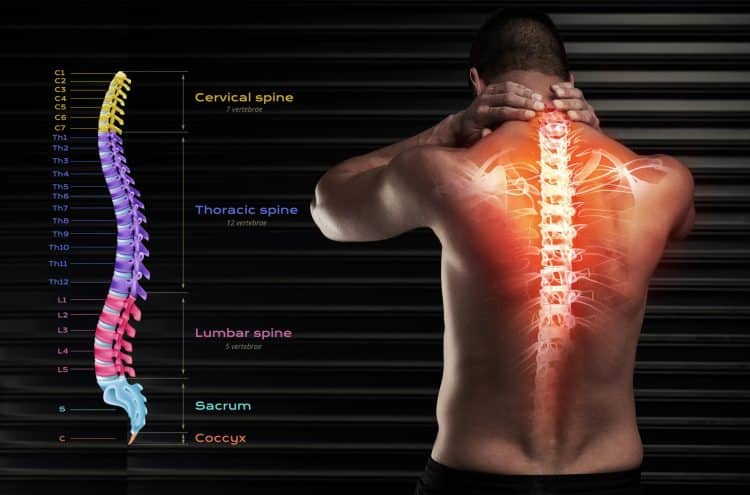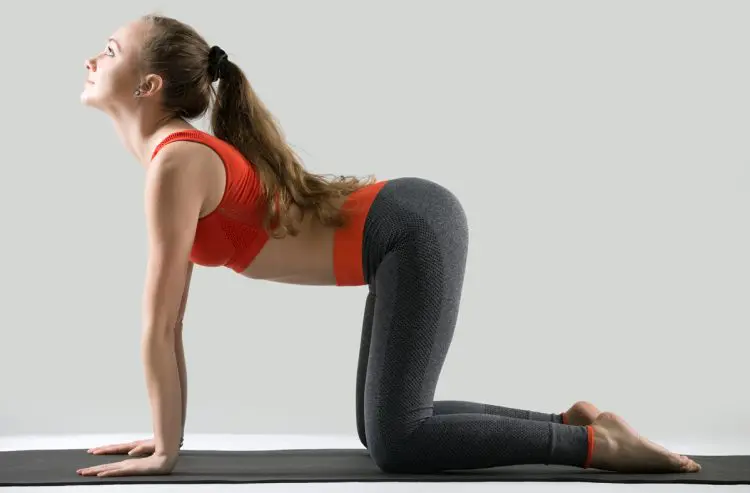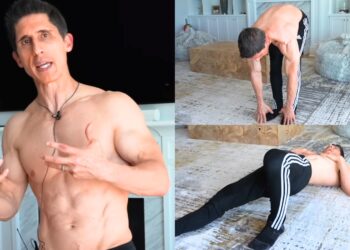Your spinal column is a truly amazing feat of biomechanical engineering. It provides an platform for your head, arms, and legs, can support hundreds of pounds, absorbs shock like a spring, and performs a wide range of movements.
With all those functions, it’s no wonder that even mild back pain is so debilitating. After all, your spine is involved in everything you do. In fact, back pain can even affect your ability to perform passive activities such as sitting and sleeping.
Most incidences of back pain involve the lumber spine or lower back. In fact, according to studies, over eighty percent of adults will experience some form of back pain during their lifetimes [1].
However, the lower back is just one part of your spine, and there are other areas that also deserve your care and attention.
In this article, we’re going to take a look at the thoracic spine and reveal the best stretches to keep it mobile and healthy.
Thoracic Spine Structure and Functions
Your spine is made up of 33 bones called vertebrae. These bones are grouped into five sections. While the vertebrae work together, each section has functions that make it unique.
Level Up Your Fitness: Join our 💪 strong community in Fitness Volt Newsletter. Get daily inspiration, expert-backed workouts, nutrition tips, the latest in strength sports, and the support you need to reach your goals. Subscribe for free!
The five vertebral sections are:
- Cervical spine – the neck (7 vertebrae)
- Thoracic spine – upper and mid-back (12 vertebrae)
- Lumbar spine – lower back (5 vertebrae)
- Sacrum – pelvis (5 fused vertebrae)
- Coccyx – “tail bone” at the bottom of the spine (4 fused vertebrae)

The thoracic spine plays a vital role in posture and is the attachment point for your ribs. It houses and protects vital organs and is affected by many upper body muscles, including the lats, pecs, and abdominals. The T-spine bridges the gap between your upper and lower body, playing a critical part in every movement you make.
The thoracic spine is capable of several movements:
- Flexion (bending forward)
- Extension (bending backward)
- Rotation (twisting)
- Lateral flexion (bending sideways)
However, long periods of sitting, tight muscles, and poor posture often mean that these movements become restricted. Impeded T-spine mobility can have a knock-on effect to other parts of your body.
For exercisers, the thoracic spine is crucial for your ability to lift weights overhead. Thoracic spine immobility makes it much harder to raise your arms above your head. If the T-spine cannot move freely, you’ll probably find yourself leaning back using your lumber spine, putting unwanted stress on that region.
You may also need to force your shoulders backward, placing unwanted pressure on your shoulder joints.
Symptoms that are often caused by poor thoracic mobility include:
- Shoulder pain.
- Tingling/pain in the upper arms.
- Neck tightness and pain.
- Lower back tightness and pain.
- Upper arm weakness.
- Grip weakness.
- Impeded breathing.
In some instances, issues with thoracic mobility can degenerate and become thoracic outlet syndrome. This is where the brachial nerves are compressed, leading to weakness and dysfunction in the arms and hands. However, even mild thoracic immobility can be troublesome albeit less serious.
The good news is that there are plenty of stretches and exercises that you can do to restore lost thoracic mobility and maintain it going forward. A few minutes of work per day are all you need to fix your immobile thoracic spine.
How Do You Know If Your Thoracic Spine is Immobile?
If you have clicked on an article about thoracic spine stretches, it’s a safe bet that you already think you have an issue with T-spine mobility. But before you start trying to fix the problem, it’s worth taking a moment to confirm your suspicion.
Also, assessing your current thoracic spine mobility will give you a reference point to measure your improvements.
To determine how mobile (or immobile) your thoracic spine is, perform the following tests:
Seated thoracic spine rotation test
This test will determine how far you can rotate your thoracic spine. Rotational movements are relatively rare and, as such, many people have difficulty twisting.
- Sit on a chair or bench with your feet flat on the floor, and your legs bent to around 90 degrees. Place your feet together.
- Hold a yoga block or cushion between your legs and squeeze it as hard as possible with your knees. This will help immobilize your lumber spine.
- Cross your arms over your chest, so your hands are resting on the opposite shoulders.
- Without turning your hips, rotate your upper body as far as you can to the left without forcing the movement.
- Relax, return to the center, and then rotate to the right.
You should be able to achieve at least 45 degrees of rotation in each direction.
Standing thoracic spine extension test
Prolonged sitting means that most people spend much of their time in a flexed position. This makes thoracic extension something of a rarity. Poor T-spine extension is a problem that many people experience.
- Stand with your back to a wall, feet around 12 inches away. Lean your butt, upper back, and head against the wall.
- Tuck your chin in and lengthen your neck. Your lower back should be slightly arched. Brace your core to maintain this arch.
- Place one hand on top of the other in front of your hips.
- Keeping your elbows straight, raise your arms, and try to touch the wall above your head. Do not allow the movement to come from your lower back.
- Lower your arms, switch your hands around, so the other one is on top, and repeat.
You should be able to place the backs of your hands against the wall without arching your lower back.
Standing thoracic lateral flexion test
Lateral flexion or bending sideways involves both the lumbar and thoracic spine. This test will determine if your lumbar spine is doing more work than it should.
- Stand with your feet roughly shoulder-width apart, knees slightly bent.
- With your arms by your sides, lean sideways and slide your hand down the outside of your leg. Go as far as comfortably possible.
- Return to the center and repeat on the other side.
- Ask a partner to observe your movements and determine which parts of your spine are moving.
You should be able to reach a 45-degree angle, with 20 degrees coming from your lumbar spine and the remaining 25 degrees from your thoracic spine.
Thoracic spine flexion test
Most people already have a rounded upper back. Therefore, it’s not usually necessary to measure thoracic spine flexion. If you can hunch over a keyboard or phone, you probably have more than enough mobility in this area!
So, just assume you’ve passed this test and focus mainly on improving (in order of importance):
- Thoracic spine extension.
- Thoracic spine rotation.
- Thoracic spine lateral flexion.
The 12 Best Thoracic Spine Stretches
Having completed the tests in the previous section, you should now have a pretty good idea what aspects of thoracic spine mobility you need to work on. So, in most cases, it’ll be all of them!
Based on your results, pick the movements that best address your thoracic spine mobility needs. So, for example, if you scored badly on the T-spine extension test, focus on exercises designed to improve thoracic extension.
However, before you begin, make sure you spend a few minutes warming up as warm muscles and joints flex and stretch more readily. A few minutes of light cardio and some general mobility exercises will suffice.
- Cat/Cow
- Segmented thoracic flexion and extension
- Quadruped thoracic rotation
- Childs pose with arms extended
- Book openers
- Foam roller thoracic extension
- Bench thoracic spine stretch
- Single-arm lat stretch
- Thread the needle
- Seated waist twist
- Kitchen sink thoracic stretch
- Dead hang
1. Cat/Cow
Cat/cow is a flexion/extension yoga exercise that mobilizes your entire back, including that all-important thoracic spine. This move is a great way to warm up your spine before moving on to more demanding exercises.
Steps:
- Kneel on all fours with your knees directly beneath your hips and your hands under your shoulders.
- Lower your head, tuck your pelvis under, and lift the middle of your back up toward the ceiling. Shrug your shoulders forward and press your hands into the floor to maximize T-spine movement.
- Next, raise your head, tilt your pelvis the other way, and try to lower your abdomen down toward the floor.
- Alternate smoothly between these two positions for 5-10 reps or until you feel your spine becoming more mobile.

2. Segmented thoracic flexion and extension
This simple yet challenging exercise will mobilize your thoracic spine and teach you how to move it one vertebra at a time. It’s also a valuable exercise for reinforcing good posture. Do this exercise to break up long periods of immobility and sitting.
Level Up Your Fitness: Join our 💪 strong community in Fitness Volt Newsletter. Get daily inspiration, expert-backed workouts, nutrition tips, the latest in strength sports, and the support you need to reach your goals. Subscribe for free!
Steps:
- Sit or stand with your back against a wall. Tuck your chin in toward your chest. Cross your hands over your chest and rest them on the opposite shoulders. Press your back firmly into the wall.
- Moving one vertebra at a time, starting from the top, roll your T-spine down until your upper back is fully flexed.
- Then, reverse the motion until you are back in the starting position.
- Repeat 3-5 times.
- You can also do this exercise unsupported, i.e., without the wall. However, this does take more awareness and control.
3. Quadruped thoracic rotation
If you do any rotation in your workouts, it’s probably your lumbar spine that you’re twisting. This makes sense, given that the obliques are largely responsible for that movement. Thoracic rotation is much rarer, which is why so many people struggle with this movement. The quadruped thoracic rotation exercise is designed to help relieve this problem.
Steps:
- Kneel on all fours with your hips over your knees and shoulders over your hands.
- Sit back and lower your butt down toward your heels.
- Place your left hand where your right hand was and put your right hand on your temple.
- Rotate your upper body and raise your bent elbow up toward the ceiling.
- Next, rotate back down and lower your bent elbow toward your supporting hand.
- Repeat for 3-5 slow, controlled reps, and then swap sides.
4. Childs pose with arms extended
This yoga exercise is a great way to work on thoracic extension while relaxing your upper body and lower back. If you performed poorly in the T-spine extension test, this exercise will undoubtedly help.
Steps:
- Kneel on all fours with your feet together and knees wide apart. Place your hands out in front of you, palms flat on the floor.
- Ease your hips back and sit on your heels while keeping your arms straight. Lower your head and chest down toward the floor.
- Relax in this position for 1-3 minutes, allowing gravity to gently pull your chest lower to the ground.
- Move your hands further forward if necessary.
5. Book openers
Book openers are a therapeutic exercise that increases T-spine rotation, mobilizes your shoulders, and stretches your chest, obliques, and lower back. While this exercise is not easy, it’s very rewarding and provides a lot of bang for your buck.
Steps:
- Lie on your side with your legs and hips bent to about 45 degrees.
- Extend your arms out in front of you with your palms together.
- Raise your uppermost arm and rotate your body to touch the floor behind you with the back of your hand. Don’t worry if you can’t quite reach the floor yet.
- Return to the starting position and repeat for 3-5 slow, controlled reps. Your range of motions should increase rep by rep.
- Roll over, switch sides, and repeat.
6. Foam roller thoracic extension
Do you spend a lot of time hunched over a keyboard? Then this is the thoracic spine stretch for you! Using a foam roller means you’ll be able to take your T-spine into full extension, using gravity to unload your upper back.
You MAY hear a few pops and cracks when you do this exercise for the first time. This is nothing to worry about and is just your thoracic vertebrae shifting back into position.
Steps:
- Lie on your back with your legs bent and feet flat on the floor. Rest your upper back across your foam roller. Place your hands behind your neck with your elbows pointing forward.
- Lean back and let gravity extend your T-spine over the roller. Make sure you do not overextend your lumbar spine. Instead, most of the movement should come from your upper back.
- Roll up and down your thoracic spine, but do not allow the roller to move under your neck or lower back.
- Continue for 1-2 minutes or until your lumbar spine has been sufficiently mobilized.
7. Bench thoracic spine stretch
Use this exercise to stretch your thoracic spine before overhead presses at the gym or between sets if you feel that you are arching your lower back or overextending your shoulders too much. This is quite an intense thoracic spine stretch, so don’t worry if you can’t go all that deep.
Steps:
- Kneel in front of an exercise bench. Place your elbows on the bench about shoulder-width apart. Bend your arms and place your hands behind your head. Hold a short pole in your hands if you have one; otherwise, place your palms together.
- Ease your hips back and lower your chest down toward the floor. Take care not to hyperextend your lower back.
- Stay in this position for 30-60 seconds, and then slowly release.
- You can also do this exercise with straight arms, which some people will find more comfortable.
8. Single-arm lat stretch
So, while this exercise IS a lat stretch, it will also stretch your thoracic spine laterally. Most lat stretches hit both sides at the same time, and while that’s good for your lats, it’s not so helpful for your T-spine. Do this exercise instead of your usual lat stretch to mobilize your T-spine and improve lat flexibility.
Steps:
- Stand in front of a sturdy post, e.g., a squat rack. Hold the bar at about waist-height with one hand.
- Step back and lean forward, so your upper body is roughly parallel to the floor.
- Sit your hips back and curve your upper body away from the post. This provides a deeper lat stretch and increases the lateral bend in your thoracic spine.
- Hold for 30-60 seconds, and then swap sides.
9. Thread the needle
Thread the needle might sound like an odd name for an exercise, but it’s actually a great way to stretch and mobilize your thoracic spine and shoulders. Do this exercise as part of your upper body warmups, or anytime you need to loosen up your upper back.
Steps:
- Kneel on all fours with your hands beneath your shoulders and your knees under your hips. Brace your abs and adopt a neutral spine, i.e., slightly arched lower back and chi tucked in.
- Take one arm and put it between your supporting hand and leg, i.e., thread the needle. Rotate your entire upper body and head to reach as far as comfortably possible.
- Bring your arm back through and then extend it up toward the ceiling. Repeat 5-10 times and then swap sides.
10. Seated waist twist
Despite its name, this exercise will stretch and mobilize your thoracic spine and not just your waist. Do this exercise to break up long periods of sitting at your desk. Using your arms means you’ll be able to stretch a little deeper during this exercise.
Steps:
- Sit sideways on a chair with your feet planted firmly on the floor, your legs bent to 90 degrees, and your torso upright.
- Turn your upper body and grasp the backrest.
- Use your arms to gently turn your upper body as far as comfortable. Keep your hips still to ensure the movement comes from your thoracic spine.
- Hold for 30-60 seconds, release, and swap sides.
11. Kitchen sink thoracic stretch
This stretch is so-called because you can do it in your kitchen. Location-specific names aside, this is an excellent thoracic spine stretch that you can perform anywhere you can find a waist-high platform on which to rest your hands.
Steps:
- Stand facing your kitchen sink or similar. Place your hands on the top and take a step back.
- Bend your knees slightly, hinge forward from the hips, and lower your chest and head down between your arms. Take care not to round your lower back.
- Hold for 30-60 seconds, and then relax.
- Add some lateral flexion to this exercise by shifting your hips left and right while keeping your arms stationary.
12. Dead hang
The dead hang is a great way to decompress your entire back, including your T-spine. The thoracic spine can become compressed by the weight of your head and the barbells and dumbbells you lift in the gym. Dead hangs use gravity to gently distract and open up your vertebrae. This exercise can also help alleviate many sources of shoulder pain. Want a stronger grip? Dead hangs can help with that, too!
Steps:
- Find somewhere suitable to hang. You should be able to touch the bar without jumping. Use a step or a bench to ensure that you can comfortably reach the bar.
- Hold the bar with an overhand, slightly wider than shoulder-width grip. Chalk your hands if your palms are sweaty.
- Hang from the bar with your arms and body straight and your feet off the floor. Do not fully relax your shoulders. Instead, keep them active by pulling them slightly down and back. Do not hold your breath.
- Remain motionless – no swinging or twisting – for the duration of your set. When you are done, step rather than jump down as jumping will shock load your spine, negating some of the decompressing benefits of this exercise.
Thoracic Spine Stretches – FAQs
Do you have a question about thoracic spine stretching? No worries because we’ve got the answers!
1. Which thoracic spine stretches should I do?
With 12 different stretches to choose from, you may be wondering which ones you should do. The only person who knows the answer to that question is you! Your personal thoracic spine stretching routine depends on your score from the tests covered earlier in this article.
For example, suppose you passed the rotation and lateral flexion tests but failed the extension test. In that case, you should focus almost exclusively on thoracic extension exercises like foam roller thoracic extensions and dead hangs. In contrast, if you need to work on thoracic rotation, thread the needle and book openers should be your priority.
So, treat what you find, and use the exercises that best match your mobility needs and goals.
2. How often should I do thoracic spine stretches?
The more immobile your thoracic spine is, the more often you should stretch and mobilize it. For example, if you failed all of the thoracic mobility tests, you should probably work on your thoracic spine a couple of times per day, seven days a week.
But, if you aced all the tests and just want to maintain your current level of mobility, 3-4 times per week should suffice.
So, adjust the frequency based on your needs and goals, doing more if your thoracic spine needs extra attention and less if things are already pretty good.
3. I find some of these stretches painful. Should I still do them?
While some mild discomfort is expected when stretching, pain is best avoided. If any of these exercises hurt, dial things back a notch and don’t stretch so deeply. If that doesn’t help, just switch to another exercise.
Pain that radiates down your arms or legs or results in a burning sensation suggests you are over-stretching and potentially doing more harm than good. Be patient, don’t try and do too much too soon, and choose exercises that suit your body type.
4. Will stretching my thoracic spine improve my posture?
Posture refers to the alignment of your joints, which can be good or bad. One example of bad posture is hyperkyphosis, where the thoracic spine becomes excessively rounded. Stretching the T-spine and emphasizing thoracic spine extension can help reduce kyphosis and improve your posture.
However, if you want to fix your posture for good, you need to try and avoid the causes of bad posture, i.e., sitting for long periods with a rounded back, not training your back enough, and spending too much time working on your pecs and abs.
Unless you address the causes of bad posture, even daily thoracic spine stretches won’t help you sit and stand more upright.
5. How long should I hold thoracic spine stretches for?
Generally, the longer you hold a stretch, the more it will improve your flexibility. So, to develop better thoracic spine mobility, do your chosen stretches for 30 to 60 seconds or longer. Relax into the stretch and try to go a little deeper as you feel the tension leave your muscles.
However, shorter stretches are more appropriate if you are happy with your flexibility and just want to maintain it. In this case, you can hold your stretch for 10-15 seconds.
For stretches performed for reps, e.g., cat/cow and thread the needle, do 5-10 slow reps to mobilize your T-spine, although you can do more reps if you’re feeling stiff.
Read more:
- Best Back Stretching Exercises
- 4 Strength Tips For Guarding Your Back
- Best Exercises For Bigger, Stronger And Pain-Free Back
- Best Old-School Back Workouts
- Best Lower Back Exercises + Workout
- Thoracic Extensor Exercises for A Stronger Upper Back
- Cable Machine Exercises for A Bigger Back
Thoracic Spine Stretches – Closing Thoughts
Most people are aware of their lumbar spine and take care of it with plenty of stretching and strengthening exercises. However, when it comes to the thoracic spine, many exercisers are blissfully unaware and only pay attention to it when something goes wrong.
Contrary to popular opinion, the thoracic spine is every bit as important as the lumbar spine and, for lifters, is critical for correct overhead lifting performance and shoulder health.
So, it’s time to stop neglecting your T-spine. Use the exercises in this article to stretch and mobilize your thoracic spine and improve your upper back health and function.
References:
- PubMed: The Rising Prevalence of Chronic Low Back Pain.








